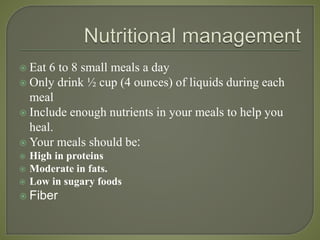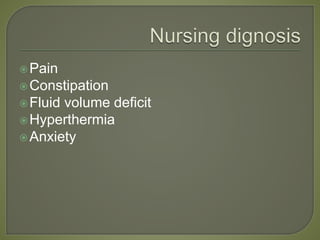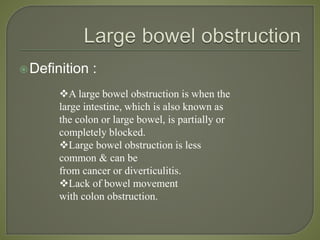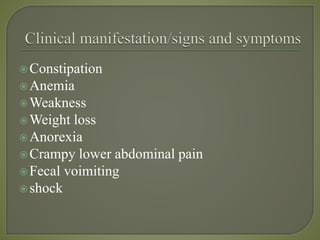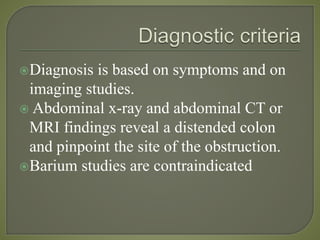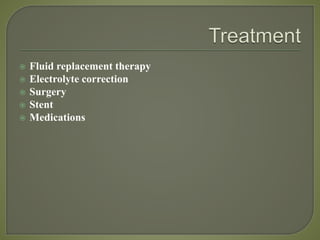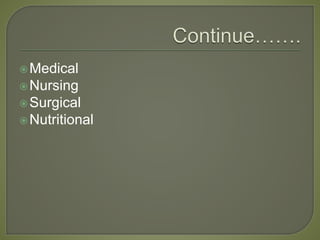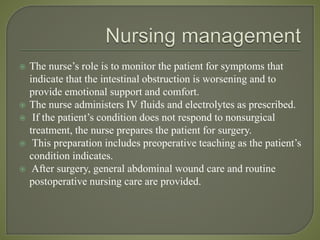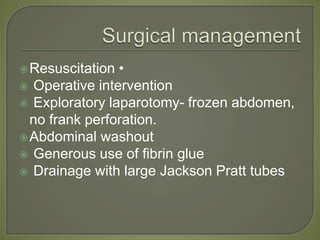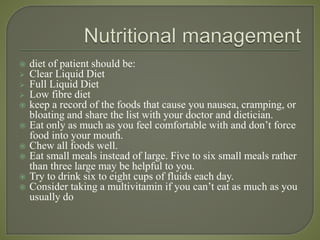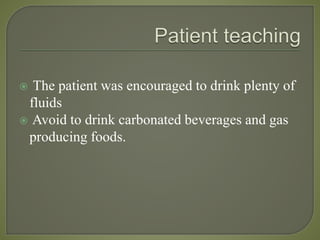Intestinal obstruction surgery adult health nursing.pptx
- 2. Definition : Intestinal obstruction exists when blockage prevents the normal flow of intestinal contents through the intestinal tract. Two types of processes can impede this flow: • Mechanical obstruction: An intraluminal obstruction or a mural obstruction from pressure on the intestinal wall occurs. Examples : Intussusception, polypoid tumors and neoplasms, stenosis, strictures, adhesions, hernias, and abscesses. • Functional obstruction: The intestinal musculature cannot propel the contents along the bowel. Examples : Amyloidosis, muscular dystrophy, endocrine disorders such as diabetes mellitus, or neurologic disorders such as Parkinson’s disease. The blockage also can be temporary and the result of the manipulation of the bowel during surgery.
- 4. The obstruction can be partial or complete. Its severity depends on the region of bowel affected, the degree to which the lumen is occluded, and especially the degree to which the vascular supply to the bowel wall is disturbed. Most bowel obstructions occur in the small intestine. Adhesions are the most common cause of small bowel obstruction, followed by hernias and neoplasms. Other causes include intussusception, volvulus (ie, twisting of the bowel), and paralytic ileus. Most obstructions in the large bowel occur in the sigmoid colon. The most common causes are carcinoma, diverticulitis, inflammatory bowel disorders, and benign tumors.
- 5. The small intestine is the part of the digestive system that absorbs much of the liquid and nutrients from food. It consists of three segments: The Duodenum The Jejunum The Ileum and is followed by the large intestine (colon).
- 6. Definition : Small bowel obstruction can have abdominal pain with frequent vomiting. True bowel obstruction can be very serious.
- 7. o Intestinal contents, fluid, and gas accumulate above the intestinal obstruction. o The abdominal distention and retention of fluid reduce the absorption of fluids and stimulate more gastric secretion. o With increasing distention, pressure within the intestinal lumen increases, causing a decrease in venous and arteriolar capillary pressure. o This causes edema, congestion, necrosis, and eventual rupture or perforation of the intestinal wall, with resultant peritonitis. o Reflux vomiting may be caused by abdominal distention. o Vomiting results in loss of hydrogen ions and potassium from the stomach, leading to reduction of chlorides and potassium in the blood and to metabolic alkalosis. o Dehydration and acidosis develop from loss of water and sodium. o With acute fluid losses, hypovolemic shock may occur.
- 8. Crampy pain Voimiting Dehydration Intense thirst Drowsiness Malaise Aching Parched tongue and mucous membrane Acidosis Alkalosis Hypovolemic shock Septic shock
- 9. Adhesions, or tissue that can develop after abdominal or pelvic surgery Diverticulitis A foreign object, if swallowed Gallstones, though this is a rarer cause of obstruction Hernias Impacted stools Infection Inflammatory bowel diseases (IBDs) Intussusception, which is when a segment of the bowel pushes into the next segment, making it collapse Meconium plug, which is the first stool that newborns pass Tumors A twisted bowel
- 10. dehydration electrolyte imbalance tissue death in the bowels abscess within the abdomen kidney failure a hole in the bowel, which could lead to infection pulmonary aspiration, wherein a person inhales solids such as vomit Sepsis a potentially fatal blood infection
- 11. Cancer, especially in the abdomen Crohn's disease or other IBDs, which can thicken the walls of the intestines previous abdominal or pelvic surgery, which may increase the risk of adhesions. radiation therapy. bulging through the incision (incisional hernia) narrowing (stricture) of the opening (stoma) blockage (obstruction) of the intestine from scar tissue
- 12. Diagnosis is based on the symptoms described previously and on imaging studies. Abdominal x-ray and CT findings include abnormal quantities of gas, fluid, or both in the intestines. Laboratory studies (ie, electrolyte studies and a complete blood cell count) reveal a picture of dehydration, loss of plasma volume, and possible infection.
- 13. Treatment options for small bowel obstruction can include: Medication. Observation Nasogastric tube Surgery Therapeutic enema
- 14. Treatment include: Medical Nursing surgical Nutritional management
- 15. Decompression of the bowel through a nasogastric tube is successful in most cases. When the bowel is completely obstructed, the possibility of strangulation and tissue necrosis (ie, tissue death) warrants surgical intervention. Before surgery, IV fluids are necessary to replace the depleted water, sodium, chloride, and potassium. The surgical treatment of intestinal obstruction depends on the cause of the obstruction. For the most common causes of obstruction, such as hernia and adhesions, the surgical procedure involves repairing the hernia or dividing the adhesion to which the intestine is attached. In some instances, the portion of affected bowel may be removed and an anastomosis performed. The complexity of the surgical procedure depends on the duration of the intestinal obstruction and the condition of the intestine.
- 16. Nursing management of the nonsurgical patient with a small bowel obstruction includes maintaining the function of the nasogastric tube, assessing and measuring the nasogastric output, assessing for fluid and electrolyte imbalance, monitoring nutritional status, and assessing improvement (eg, return of normal bowel sounds, decreased abdominal distention, subjective improvement in abdominal pain and tenderness, passage of flatus or stool). The nurse reports discrepancies in intake and output, worsening of pain or abdominal distention, and increased nasogastric output. If the patient’s condition does not improve, the nurse prepares him or her for surgery. Nursing care of the patient after surgical repair of a small bowel obstruction is similar to that for other abdominal surgeries.
- 17. Principles: • Management of segment at site of obstruction. • Management of distended proximal bowel. • Management of underlying cause of obstruction.
- 18. Steps: • Nasogastric intubation and suction • Anaesthesia • Incision • Handling of gut • Assess the viability of the bowel • Prevention of reperfusion • Closing the abdomen
- 19. Eat 6 to 8 small meals a day Only drink ½ cup (4 ounces) of liquids during each meal Include enough nutrients in your meals to help you heal. Your meals should be: High in proteins Moderate in fats. Low in sugary foods Fiber
- 20. The patient was encouraged to drink plenty of fluids Avoid to drink carbonated beverages and gas producing foods.
- 22. The large intestine, also known as the large bowel, is the last part of the gastrointestinal tract and of the digestive system in vertebrates. Water is absorbed here and the remaining waste material is stored as feces before being removed by defecation.
- 23. Definition : A large bowel obstruction is when the large intestine, which is also known as the colon or large bowel, is partially or completely blocked. Large bowel obstruction is less common & can be from cancer or diverticulitis. Lack of bowel movement with colon obstruction.
- 24. As in small bowel obstruction, large bowel obstruction results in an accumulation of intestinal contents, fluid, and gas proximal to the obstruction. It can lead to severe distention and perforation unless some gas and fluid can flow back through the ileal valve. Large bowel obstruction, even if complete, may be undramatic if the blood supply to the colon is not disturbed. However, if the blood supply is cut off, intestinal strangulation and necrosis occur; this condition is life-threatening. In the large intestine, dehydration occurs more slowly than in the small intestine because the colon can absorb its fluid contents and can distend to a size considerably beyond its normal full capacity. Adenocarcinoid tumors account for the majority of large bowel obstructions. Most tumors occur beyond the splenic flexure, making them accessible with a flexible sigmoidoscope.
- 25. Constipation Anemia Weakness Weight loss Anorexia Crampy lower abdominal pain Fecal voimiting shock
- 27. infection tissue death intestinal perforation sepsis multisystem organ failure death
- 28. colon cancer diverticulitis sigmoid volvulus cecal volvulus Previous abdominal or pelvic radiation. Hernias. Twists in the bowel
- 29. Diagnosis is based on symptoms and on imaging studies. Abdominal x-ray and abdominal CT or MRI findings reveal a distended colon and pinpoint the site of the obstruction. Barium studies are contraindicated
- 30. Fluid replacement therapy Electrolyte correction Surgery Stent Medications
- 32. Restoration of intravascular volume, correction of electrolyte abnormalities, and nasogastric aspiration and decompression are instituted immediately. A colonoscopy may be performed to untwist and decompress the bowel. A cecostomy, in which a surgical opening is made into the cecum, may be performed in patients who are poor surgical risks and urgently need relief from the obstruction. The procedure provides an outlet for releasing gas and a small amount of drainage. A rectal tube may be used to decompress an area that is lower in the bowel. However, the usual treatment is surgical resection to remove the obstructing lesion. A temporary or permanent colostomy may be necessary. An ileoanal anastomosis may be performed if removal of the entire large bowel is necessary.
- 33. The nurse’s role is to monitor the patient for symptoms that indicate that the intestinal obstruction is worsening and to provide emotional support and comfort. The nurse administers IV fluids and electrolytes as prescribed. If the patient’s condition does not respond to nonsurgical treatment, the nurse prepares the patient for surgery. This preparation includes preoperative teaching as the patient’s condition indicates. After surgery, general abdominal wound care and routine postoperative nursing care are provided.
- 34. Resuscitation • Operative intervention Exploratory laparotomy- frozen abdomen, no frank perforation. Abdominal washout Generous use of fibrin glue Drainage with large Jackson Pratt tubes
- 35. diet of patient should be: Clear Liquid Diet Full Liquid Diet Low fibre diet keep a record of the foods that cause you nausea, cramping, or bloating and share the list with your doctor and dietician. Eat only as much as you feel comfortable with and don’t force food into your mouth. Chew all foods well. Eat small meals instead of large. Five to six small meals rather than three large may be helpful to you. Try to drink six to eight cups of fluids each day. Consider taking a multivitamin if you can’t eat as much as you usually do
- 36. The patient was encouraged to drink plenty of fluids Avoid to drink carbonated beverages and gas producing foods.
- 37. Pain Constipation Ineffective breathing pattern Deficit fluid volume Anxiety


















